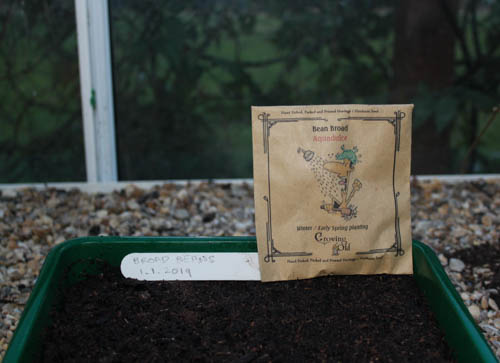
If you missed sowing broad beans in autumn, sow some now under glass for an early summer harvest, 5-8cm apart and 2.5cm deep in deep trays of multipurpose compost or singly in small pots. Put them in a cool frost-free greenhouse, and harden them off before planting outdoors in early spring. Use the hardy varieties ‘The Sutton’ and ‘Robin Hood’ – both dwarf and ideal for windy sites; ‘Aquadulce’ and ‘Aquadulce Claudia’.
It is not always practical to grow everything from seed so it is worth planning a list of plants which you intend to sow and those which you will buy as plug plants, then check the prices and where to buy them. Plug plants not only save time and space in the greenhouse but heating costs, too.
If you are going to grow tomatoes from seed, make early sowings at 18C later in the month and also onions under gentle heat (see December for more details). Sow Radish, Spring Onions and ‘cut and come again’ baby salad leaves in pots or troughs of multipurpose compost for early salads after 40-50 days.
Sweet peas can be sown now. To encourage germination, lay a sheet of kitchen towel on a dinner plate, moisten it with water, put the sweet pea seeds on the paper, cover with another layer of kitchen towel carefully drain away the excess water, then put them in a cool room. Soaking this way ideally overnight and for a maximum of 48 hours and viable seeds will start to swell. They can then be transferred into 7.5cm pots of multipurpose compost or Rootrainers.
Sow Geraniums or Begonias in a heated propagator at a minimum of 21C (70F). Lightly cover geranium seed with fine grade vermiculite. Begonia seeds are best sown on the surface of moist compost but do not cover as they need light to germinate.
Strawberries that were lifted and potted up last summer, can be brought into the greenhouse. Place them near the glass for maximum light. Once they start flowering, pollinate them by hand, transferring pollen from one flower to another using a fine artists brush. Keep the compost moist and feed with dilute tomato fertiliser every two weeks to encourage flowering and fruiting. They can then be hardened off and planted outdoors later in the season.
Only water when pots show signs of drying out, remove leaves showing signs of grey mould, keep an eye out for pests like whitefly and red spider mite in warmer periods. Ventilate during warmer periods but close vents before temperatures drop, by midafternoon at the latest.
Check stored Dahlia and Begonia tubers. Remove rot with a sharp knife and dust the wound with green Sulphur. Badly affected tubers should be disposed of and replaced.
Detach the main stems of grapes from their frame and scrape off the loose bark, this can then be winter washed to control pests like red spider mite and mealy bug. If you haven’t already done so, cut back last year’s stems to within one bud of the main framework, this job needs in the early days of the month.
Happy New Year. Matt


